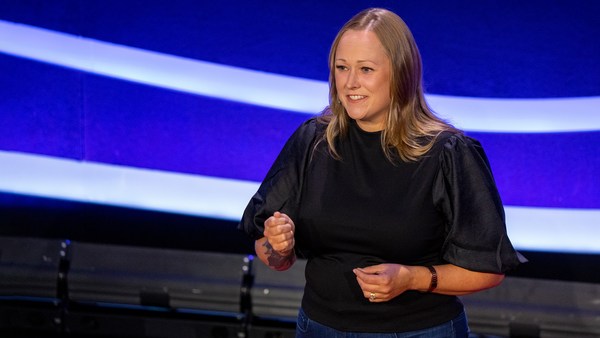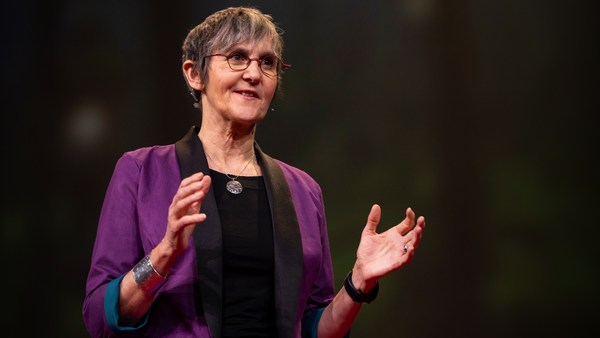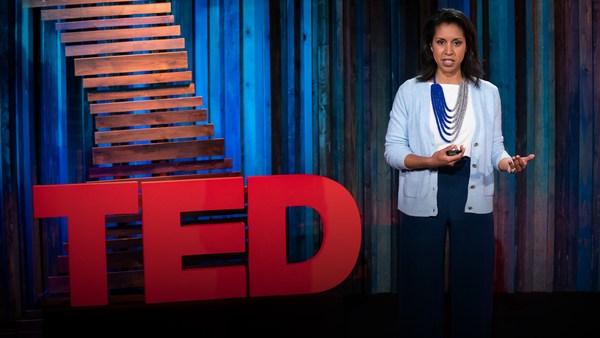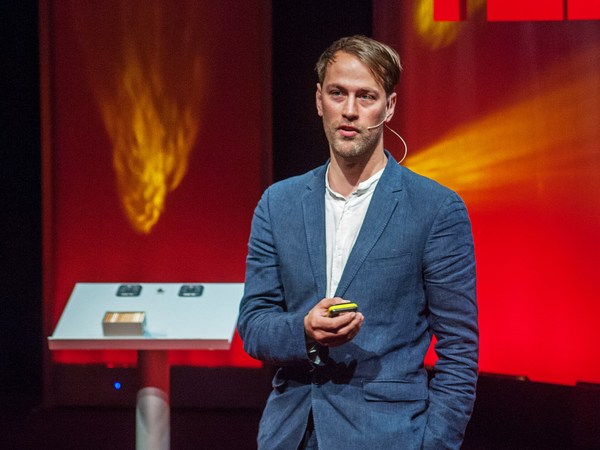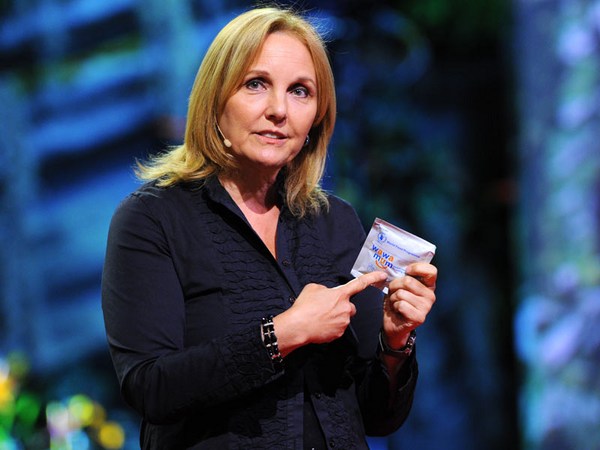Lindsay Levin: Great to be here with you. And you started your career at Nestlé in a beverage factory in Suffolk, Virginia, I believe, way back when. And today you run the largest business division of the world's largest food company. Give us a sense of what that means.
Steve Presley: Yeah, obviously, as you said, Nestlé is the world's largest food company. It's also one of the largest food and beverage companies in North America. And I would bet the majority of the people in the room have a Nestlé product in your house. We're actually in 95 percent of the households in the US with one of our brands. And if you think about our brands, most people know us through our brands DiGiorno, Stouffer's, Hot Pockets, Starbucks at home, Coffee-mate or any of our Purina petcare products. And so we have a really broad, vast portfolio of products. And as we work across that, how do we bring that to life? And we bring it to life with 30,000 amazing team members around the country that are spread around 119 facilities in 28 different states that really are focused on trying to make our business and the contributions to the society much better every single day.
But if you kind of step back at a global level, we actually sell a billion Nestlé products every single day in 188 countries around the world. So massive scale. And to do that, we work directly with 500,000 farmers around the world, directly and indirectly over a million.
LL: So that's a lot of responsibility, right? We think about food, we think about farming, we think about the responsibility of the agricultural industry in terms of soil, in terms of water, in terms of emissions. Give us a sense of the challenges that you're now seeking to address as you think forward in terms of farming and food.
SP: Sure. I mean, look, food production in total accounts for about 30 percent of total greenhouse gas emissions. And at the core of that is agriculture. And for us, that's why regenerative agriculture is so important. For us to continue to make progress on our net-zero commitment, we actually have to see these farming practices adopted at more scale. And when you think about that, it's easy to say and it's very hard to do. Just take it to the US level alone. There’s two million farms in the US, and for us, we source over 2,600 agricultural ingredients from thousands of farms across the country. And within that 2,600, every single crop has a different challenge to actually get to regenerative practices. Carrots are different from apples which are different from dairy which are different from beef. And so the complexity and scale of that challenge across that is incredible because it's not just one solution that can be applied. And secondly, as we talk to our farming partners, we really talk to our suppliers to understand. They're incredibly interested in this journey. We try to put ourselves in the farmers' shoes. Imagine if this is a multigenerational farm, and you're the farmer that's changing the way you've farmed the soil for hundreds of years, and now there's a better way to do it. It's incredible risk. That's where I think for us as Nestlé, we feel like we have to play and share in that risk. And we approach it in this idea of creating shared value. And everybody says creating shared value. But for us, it has to be good for Nestlé. We’re a for-profit company and a publicly traded company, and what we do is focused around being good for us. But at the same time, we want it to be good for the farmers, good for our suppliers, good for our consumers and ultimately good for the planet.
LL: Tell us about the goals you’ve set for the company. How ambitious are you trying to be, how do you prioritize?
SP: Yeah, look, for us on the goals, we have a net-zero commitment by 2050, which seems like a long time away, but as we all know, it's tomorrow. And if we haven't already started making progress against that, we're in trouble. And we're quite proud of the fact that the progress we made in the last couple of years, we're actually beyond peak carbon and so we're reducing carbon as we move ahead. So we’re very focused on that.
And we really approach it in kind of four key pillars. We approach it with ingredients that I'll talk quite a bit about today, we approach it on packaging, manufacturing, the conversion process, and then last, the local communities that we serve.
And if I can just quickly on each one. In ingredients, you think about it, regenerative agriculture has to come to all those in a way that brings sustainable change. And so we’re very focused on that. And we have to do it across every single bucket, whether it's wheat, rice, corn. And we've got teams and programs focused across all of those categories. And for us, we've committed to be 50 percent regenerative-sourced by 2030. We're well on our way on that journey.
If you think about packaging, we're very proud of the progress we've made in packaging. We've reduced over half a million tons of plastic from our existing packaging today, with so much more to go on that journey.
And then if you think about the manufacturing conversion process, we committed to 100 percent renewable electricity across all of our facilities, and we're actually well on the way on that, we're at 50 percent. We've been able to reduce our scope to emissions around that already. We're invested in two massive solar farms in Texas that have allowed us to do that, and we continue to push that forward. All of our factories in the US actually are zero waste to landfill already today.
And then lastly is in the local farming communities. And when we talk about working with the farmers, just a couple examples. You know, if you think about the work we do in the Côte d’Ivoire on cocoa farmers, really it's providing financial incentives directly to the farmers to actually encourage these practices and at the same time encourage child education and agroforestry work. So that's just kind of how we think about how we prioritize across the list.
LL: Now, I want to take you back to this term “regenerative farming,” because it seems to me this is one of these things everybody's going to self-define and then we kind of dumb it down and we don't really know what we're talking about. What what do you mean by that? And how do you hold yourself to a standard?
SP: I'm sure there have been much better speakers and much smarter people in the course of this session that have actually defined it more eloquently than I have. But when I look at it, ultimately at the end of every crop cycle, have we improved the soil and the biodiversity of the resources we use to produce those? And if we have, then we're moving forward in regenerative farming. And it's incredibly powerful. And it sounds a bit academic or maybe a little far out there, but really when you get down to it, some of the practices are simple as crop rotation, live root farming, low-till, no-till. And those are relatively easy to implement. Still different and challenging for the farmers. All the way to multimillion-dollar installations of manure systems that actually can reduce greenhouse gases on dairy farms. And so the scale and complexity of the application of solutions is very different as we work through that.
LL: And what are you doing to actually advance those practices?
SP: You know, when we think about it, I think the best way to bring it to life is maybe focus it on a product. And we're in Detroit, which is a great pizza city. And so let's talk about pizza. Every great pizza starts with a great crust and the crust in DiGiorno, we're making an announcement today, where we're investing in over 100,000 acres of wheat farming in the US with our partners to be able to produce enough wheat to double the production required for DiGiorno pizza. And so we'll have regenerative wheat through that.
And then you move to the tomatoes. Today, it’s not about getting more farms to actually move to regenerative practice, and tomatoes, the majority of our tomatoes are already regeneratively farmed. And so it's about external verification. So we're working with an external firm called Leading Harvest that's actually help us not only just, one, we’ve already got the farmers doing it, but how do we verify it over time, how do we continue to do that? So we work through the tomatoes and I think really good progress in that space.
And then when you go to dairy, dairy is one of the toughest ones and we're quite proud, we were the first company to join the US Dairy Net Zero Initiative, and we have live farms working in California today or around the country today that are really focused on applying these practices that can get to net zero emission for a dairy farm and at the same time, is it economically viable for the farmer? And we're really proud of the progress we're making with some of our farming partners out there.
And then the last one is meat, and we all love a good pepperoni or topping on the pizza. And when you go to meat, we actually have the largest partnership, it's early days, we're just moving ahead with it, but the largest private partnership with Cargill and the National Wildlife and Fish Foundation to actually have regenerative ranching practices in over 15 states. So as you kind of think through the pizza, you can see that it touches every single component, and every single one is a different application and solution.
LL: So there's a lot and this is difficult. Where are you not moving fast enough yet?
SP: Where are we not moving fast enough? You know, for us, I think clearly, when you go to try to drive this kind of scale, it's not about one farm. It's about the farming ecosystem in total that has to change. So we need to move at scale to be able to do this across not just our business, but if we're really going to move the needle, we have to do it at industry level. And so I think just the pace of the change where we'd love to see that move a little faster.
I think secondly maybe is in packaging, when I look at packaging and recyclability, we know the recycling infrastructure is woefully insufficient in the US. It's why we've leaned in pretty aggressively. We’ve invested with partners like Closed Loop to support infrastructure, and also we support kind of responsible extended producer responsibility to actually help build that because we know that we can't make all the recyclable products we want. There is no infrastructure to do it. So at the end of the day, it doesn't get done. And so I'd say that's an area where we're really focused.
And just lastly, I think the tempo and urgency across the entire industry complex is one that we've got to pick up the pace. We've got to move much, much faster, not just to achieve our goals, but to make the kind of difference we want to make.
LL: So just to close, Steve, what can and should we expect from you all?
SP: Look, I think you'll continue to see incredible commitment. By 2025, we will have invested 3.6 billion dollars in these practices across the world for Nestlé. It's an incredible investment but we believe it's the right investment, because ultimately, when you look at our business, we're a food and beverage business that we make products for you and your families and your pets to enjoy every single day. And those start with great ingredients. And that investment for us is actually about a business decision that, we've been around for over 150 years, if we're going to be around for the next 150, we need to make sure we have great quality ingredients for that period. And so that investment actually helps us ensure that.
So what you can count on is we'll continue to drive that across all of our complexes. But most importantly, what I'm proud of, is you can count on the company and all the people that work in it. There's 30,000 in North America and there's almost 300,000 worldwide that are absolutely committed to making progress every single day against one of those commitments.
SP: Steve, thank you very much for joining us.
SP: Thanks for having me.
(Applause)
